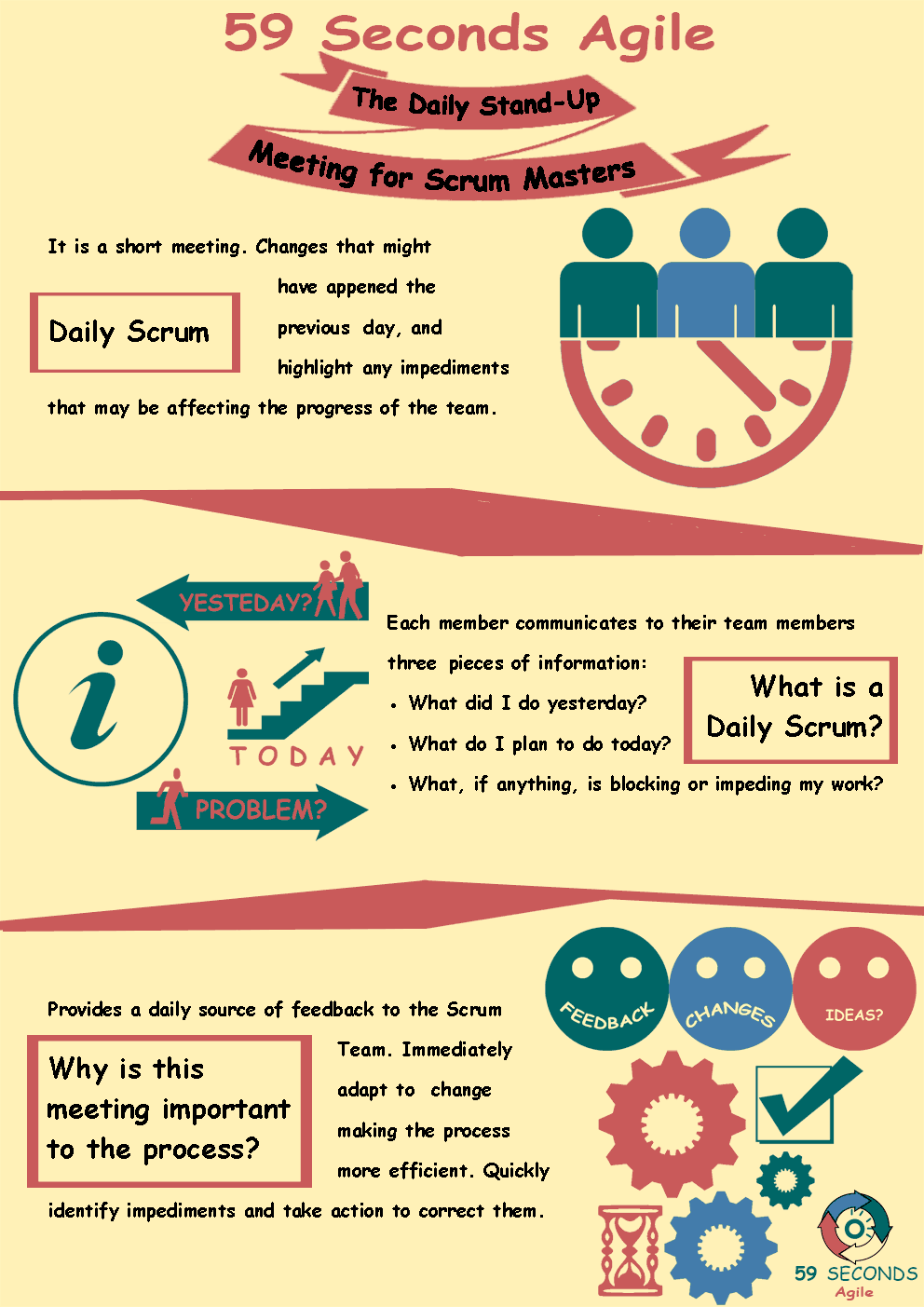What is the Daily Stand-up Meeting for and who is involved in the meeting? The Daily Stand-up Meeting is a daily feedback meeting where the development team can highlight impediments to progress.
The Agile Daily Stand-Up Meeting
A 59 Seconds Agile Video Animation
The Daily Stand-Up Meeting for Developers – Part 2
A 59 Seconds Agile Article
Kanban Boards
For the stand-up meeting to work optimally, the Scrum team requires certain tools. One of the most frequently used tools for a stand-up meeting is the kanban board. A kanban board is a visual representation of the status of every single task in a sprint. They come in a variety of forms and can be modular to suit the needs of the organization. Smaller organizations on a limited budget can use a whiteboard with sticky notes to represent tasks. These notes can be moved around on the board to indicate progress. For larger organizations with more tasks in development, there are digital kanban boards available. These digital boards will often update the display as tasks are updated within a database. Instead of having developers come in and physically move notes around, everything is automated.
The benefit of kanban boards, as with everything else in a stand-up meeting, is communication. Developers can see what tasks are at what stages, so they know what to work on next. With verbal updates, the kanban board offers redundancy. Someone who didn’t hear what one developer gave in their update, could also check on the kanban board to see where that developer’s tasks are. Although tasks aren’t always a good indicator of how much work has been done and has not yet been started, it does give insight. As tasks move from the top of the board to bottom, it gives a visual update on progress.
Participants
So who all is involved in the stand-up meeting, and how does their presence benefit developers? First and foremost, all of the developers on the Scrum team attend the stand-up meeting. Having every developer convene at the same place each day gives constant communication. Instead of having to directly ask each other through chat messages or emails, everybody gets the same information at once. This reduces the necessity to tell the same thing to several different people as they ask individually.
Daily Stand-up Meeting Attendees
In addition to the developers, other roles on the Scrum team are present at the stand-up meeting. Analysts and quality assurance technicians are involved, and answer the big 3 questions from their perspective as well. Often, this gives developers an idea of what to expect about their finished code. They don’t have to wonder if their tasks have yet to be tested, or if they just managed to write code without any errors. Each role gives updates, and ask testers to clear code, developers get an idea of whether they will need to fix problems with what they created.
Finally, the Scrum Master leads the stand-up meeting. One benefit of the Scrum Master’s presence in order. Instead of floundering around to get through the meeting, the Scrum Master guides the meeting. This reduces the total amount of time spent in the stand-up meeting. Also, the Scrum Master is responsible having issues fixed. Instead of forcing developers or other roles to seek out answers, the Scrum Master allows developers to do their own work and searches for answers themselves. This maintains efficiency while preventing slowdowns from the problems that crop up.
Obviously, the daily stand-up meeting is a valuable piece of Agile software development. Especially for developers, it gives a huge amount of regularly updated information. This makes the rest of the day run more smoothly and reduces problems that come up because of a lack of communication.
Prev <— Continue Reading —> Next
Learn More: Agile Daily Stand-Up
User Stories Applied
A 59 Seconds Agile Book Review
User Stories Applied by Mike Cohn is one of our favourite books on Agile User Stories. The book starts with an overview into user stories, and details what a user story is and the different aspects of them. He then discusses how to go about writing a user story, and provides details of the INVEST criteria that can be used to determine if the story is meeting all of its objectives. Next Mike gives an in depth discussion of who user stories are written for and where to begin when gathering the details for them. The book then discusses acceptance testing user stories, including how to go about specifying these criteria and the responsibilities of the development team and customers during this process.
Prev <— Continue Reading —> Next
Learn More: Agile Daily Stand-Up
The Daily Stand-Up Meeting
A 59 Seconds Agile Infographic

Prev <— Continue Reading —> Next
Learn More: Agile Daily Stand-Up
Our Favourite Agile Books
We found these books great for finding out more information on Agile Scrum:

